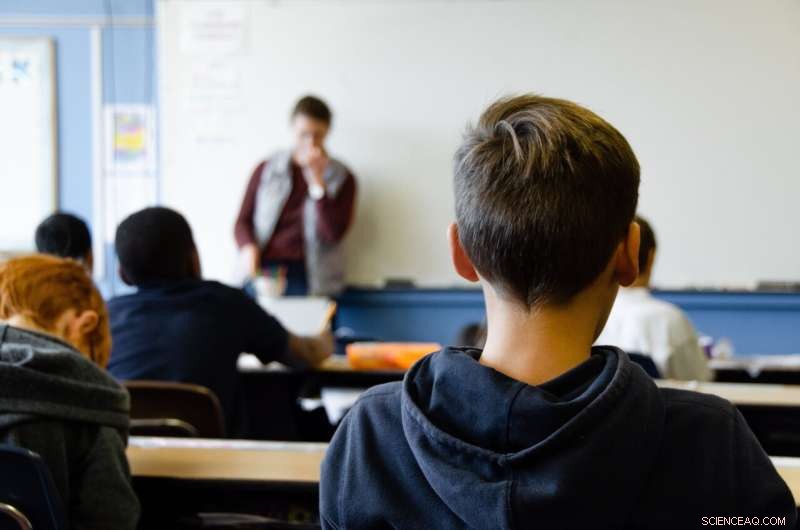
Wetenschap
Als Australische scholen de discipline van leerlingen willen verbeteren, moeten ze deze vijf problemen aanpakken

Tegoed:Unsplash/CC0 Publiek domein
NSW is bezig met het herzien van haar benadering van schorsingen en uitzettingen.
Volgens een voorgesteld plan dat in blok 4 van start gaat, kunnen studenten maximaal drie keer per jaar naar huis worden gestuurd. Dit is bedoeld om het hoge aantal sancties tegen kwetsbare kinderen op openbare scholen te verminderen. Maar het stuitte op tegenstand van leraren, die zeggen dat het de veiligheidsrisico's zal vergroten bij het omgaan met storende studenten.
Dit komt te midden van een breder debat over hoe de discipline van studenten moet worden benaderd, wat nog steeds een van de moeilijkste problemen is op Australische scholen. De opvattingen over het gedrag van studenten zijn divers en vaak gepassioneerd, waarbij sommigen beweren dat studenten 'gestraft' moeten worden.
Helaas weerspiegelen deze opvattingen niet altijd het onderzoek, waaruit blijkt dat harde benaderingen de uittreding van studenten verergeren.
Wat is schooluitsluiting?
Schorsingen en verwijderingen worden traditioneel door scholen gebruikt om problematisch leerlingengedrag te beheersen.
Ze worden gegeven aan leerlingen die de "goede orde" van scholen verstoren of de veiligheid van anderen in gevaar brengen. Scholen gebruiken schorsingen om onproductief gedrag van leerlingen te veranderen of om tijd te geven voor andere strategieën om herhaling te voorkomen.
De duur van schoolschorsingen wordt gehalveerd en leerlingen worden niet meer dan drie keer per jaar naar huis gestuurd volgens een nieuwe gedragsstrategie in NSW openbare scholen | @JordsBaker https://t.co/9KqQW1ZFqr
— De Sydney Morning Herald (@smh) 18 februari 2022
Uitsluitingen variëren in heel Australië. Ze kunnen voor een korte tijd, een lange tijd of zelfs permanent zijn.
De wetgeving van de staat en het territorium en het departementale disciplinebeleid bieden richtlijnen over hoe scholen problematisch gedrag van leerlingen in Australië moeten voorkomen en erop moeten reageren.
Recente gegevens uit staten geven aan dat schooluitsluitingen toenemen. In West-Australië was er bijvoorbeeld een nieuw record van 18.068 schorsingen in 2021, een stijging van 13% ten opzichte van 2020.
Vijf problemen die meer aandacht nodig hebben
We onderzoeken hoe en waarom Australische scholen uitsluitingspraktijken gebruiken, zoals schorsingen, om wanordelijke leerlingen te beheren.
Beleidsmakers en scholen moeten meer aandacht besteden aan de volgende zaken als het gaat om discipline en gedrag.
1. Sommige groepen studenten worden vaker geschorst
Onderzoek van de afgelopen drie decennia heeft consequent aangetoond dat schorsingen en verwijderingen onevenredig gericht zijn op studenten met verschillende achtergronden of minderheden. Dit is met name het geval voor mensen met een handicap of mensen met een specifieke raciale, etnische of klassenachtergrond.
In NSW werd in 2021 bijvoorbeeld 3,3% van alle studenten geschorst, 10% van de Aboriginal-studenten en 8,4% van alle studenten met een handicap geschorst.
Dit is niet alleen het geval in Australië, maar ook in de Verenigde Staten, het Verenigd Koninkrijk en Nieuw-Zeeland.
2. We hebben niet het volledige plaatje
Official statistics provided by education departments offer a publicly available account as to the number of students schools have suspended and expelled from schools.
However, these figures do not always present an accurate picture. Students can be excluded from the classroom in other ways, that are not captured in official data.
For example, schools might let students remain on the school grounds for partial or full days, but not let them join their peers for lessons. This allows schools to "maintain statistical respectability."
3. What else is going on in students' lives?
Often discussions on how to manage students' behavior focus on responding to the individual's academic failure, behavior or disinterest in school. They don't look at the broader complexities of their lives.
When looking at whether suspension or exclusion is an appropriate discipline technique, schools should consider the likely impact on a child's life chances, especially for marginalized children. Will a suspension put at risk the chances of the student completing school? Will the student be supervised while they are not allowed to attend school?
Understanding how poverty and other forms of social inequality contribute to behavior in schools is important.
There are many other ways to manage students' behavior that are more supportive and can lead to more positive outcomes for the school, students and families. For example, teaching students how to manage conflict or how to manage their anger.
4. Make students feel valued
Research tells us students value schools which make trust, respect and care central to everything that happens there.
If we are going to help students connect to schooling, we need to look at the deeper causes of student disengagement. This means understanding and attending to students who feel like they do not matter or do not fit in or feel like their interests are not recognized.
This requires a commitment from schools to connect to student's lives and communities as the foundation for curriculum design and learning.
Treating teachers like professionals and giving them the time and resources to plan engaging and differentiated lessons is critical. This also involves talking and listening to what young people have to say.
5. The broader political context
Schools of course exist in a broader social and political climate. In Australia, the trend in education has been to prioritize individuals and individualism over the public good.
At the broader level, this has seen an emphasis on standards, performance and national testing.
At the micro level, this encourages schools to view problem student behaviors as the responsibility of individuals. So this means there is a focus on blaming "disruptive" students, "dud" teachers or "negligent" parents, rather than look at the influence of broader public policy settings.
So, while the NSW government is making positive steps, there is still so much more to be done to improve our approach to student discipline. + Verder verkennen
Schools unfairly targeting vulnerable children with exclusion policies
Dit artikel is opnieuw gepubliceerd vanuit The Conversation onder een Creative Commons-licentie. Lees het originele artikel. 
 Sponsbacterie gevonden om arseen in te kapselen uit de omgeving
Sponsbacterie gevonden om arseen in te kapselen uit de omgeving Hoe onvolledig is het fossielenbestand?
Hoe onvolledig is het fossielenbestand?  Onderzoek vindt potentieel gevaarlijke hoeveelheden arseen in drinkwater in de gevangenis van Californië
Onderzoek vindt potentieel gevaarlijke hoeveelheden arseen in drinkwater in de gevangenis van Californië Sporen van drugs gevonden in een dam die de hoofdstad van Nigeria bevoorraadt
Sporen van drugs gevonden in een dam die de hoofdstad van Nigeria bevoorraadt NASA vangt tropische storm Francisco's nadering van aanlanding in het zuiden van Japan
NASA vangt tropische storm Francisco's nadering van aanlanding in het zuiden van Japan
Hoofdlijnen
- Denk je dat je een hersenschudding hebt? Een bloedtest kan het diagnosticeren
- Hoe kunnen nieuwe cellen iemands gezichtsvermogen herstellen?
- Nieuwe studie identificeert genetische basis voor resistentie tegen maïswortelwormen in maïs
- Hoe worden restrictie-enzymen gebruikt in de biotechnologie?
- Het verschil tussen een sporofyt en gametofyt
- Dode vissen blazen nieuw leven in de evolutionaire oorsprong van vinnen en ledematen
- Hoe een onbekende bacterie in de microbiologie te identificeren
- Hoe onderhoudt een cel homeostase?
- Microbioomtransplantaties bieden ziekteresistentie in ernstig bedreigde Hawaiiaanse plant
- Mannen worden nog steeds vaker dan vrouwen gezien als leiders, studie vondsten

- Wetenschapper benadrukt belang van multi-level denken

- Een manifest voor het onderzoeken van de impact van objectstromen op vroegere samenlevingen:Objectscapes

- Incel-terroristische aanslagen vormen een toenemende dreiging

- Newfoundland meerdere keren bevolkt door verschillende groepen, DNA-bewijs laat zien

 Katalysatorvooruitgang kan leiden tot zuinige brandstofcellen
Katalysatorvooruitgang kan leiden tot zuinige brandstofcellen Race om mensen te redden die zijn gestrand in Amerikaanse orkaan
Race om mensen te redden die zijn gestrand in Amerikaanse orkaan Supercomputing meer licht dan warmte
Supercomputing meer licht dan warmte Onderzoek suggereert dat winterslaap een waarschijnlijke optie is om verkenning van de diepe ruimte te realiseren
Onderzoek suggereert dat winterslaap een waarschijnlijke optie is om verkenning van de diepe ruimte te realiseren DNAzymes zouden beter kunnen presteren dan eiwitenzymen voor genetische manipulatie
DNAzymes zouden beter kunnen presteren dan eiwitenzymen voor genetische manipulatie Jupitermissies kunnen ook helpen bij het zoeken naar donkere materie
Jupitermissies kunnen ook helpen bij het zoeken naar donkere materie Mensen inspireren om betere levensstijlkeuzes te maken - door middel van isotopen
Mensen inspireren om betere levensstijlkeuzes te maken - door middel van isotopen NASA volgt grote tropische cycloon Cebile in Zuid-Indische Oceaan
NASA volgt grote tropische cycloon Cebile in Zuid-Indische Oceaan
- Elektronica
- Biologie
- Zonsverduistering
- Wiskunde
- French | Italian | Spanish | Portuguese | Swedish | German | Dutch | Danish | Norway |

-
Wetenschap © https://nl.scienceaq.com

